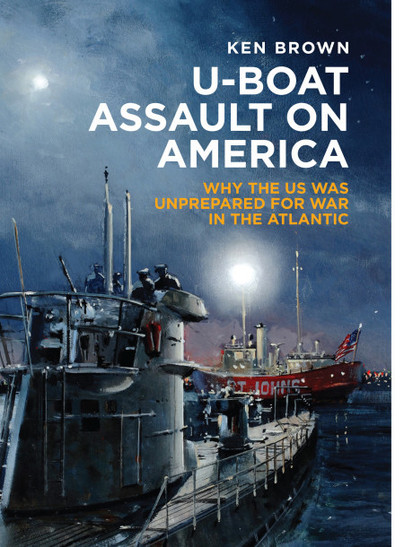
U-Boat Assault on America: Why the US was unprepared for war in the Atlantic. By Ken Brown. Seaforth Publishing, Barnsley, 2017.
Reviewed by Mike Fogarty
THIS is a review article which also locates some other key books on the threat from German U-Boats to America during WWII. The pre-war US did not fully appreciate the danger they posed to continental America and their maritime assets, merchant shipping as much as the USN itself. Until the Japanese attack on Pearl Harbour, the US was comforted that they were not at war which to them was a European construct. For two years, from its outbreak in September, 1939 Washington would increasingly become disabused.
Its commercial shipping was exposed to submarine attacks, and its warships became part of that collateral damage. The US faced an undeclared war and, while Germany was concerned to not to overly provoke the US; a war soon came to America before its formal date from 7 December, 1941.
The U-Boat fleet had a field day off the East Coast of America and in the Gulf of Mexico. For their submariners, it was the “Happy Time.” Many US tankers and freighters were sunk with impunity, for the US was slow to orchestrate a coherent policy and program to counter their silent menace. In time, the USN galvanised its response and they had the wit to learn from the RN, whose own strategy, doctrine and tactics had taught them the hard way, in remorseless undersea warfare operations.
A raiding U-Boat could only marvel at the American innocence. The Coney Island fair in New York was lit up like the proverbial Christmas tree. Elsewhere ashore, commercial interests over-rode national security expectations, as hotels and resorts were fully illuminated, lest visitor numbers suffer. Thus, shipping leaving and entering coastal ports presented an attractive silhouette to the Kreigsmarine. Crowds of civilians witnessed their own ships sinking in flames, and bodies of sailors would soon beach their unprotected shores. For the U-Boats, it was the Paukenschlag. It was a rolling coda from kettle drums, a Gotterdammerung, in full Wagnerian fury.
The book takes a long time to make its point, but it is worth the effort. Written at an academic level, it still entertains the average reader. There are a few other books out which I would not privilege. They include: ‘Torpedoes in the Gulf, Galveston and the U-Boats, 1942-1943’, by Melanie Wiggins and ‘Torpedo Junction: U-Boat War off America’s East Coast, 1942’ by Homer Hickman. Both are mainly anecdotal and do not possess the same scholarship and analytical rigour compared to Brown’s work
Brown has written a superior book as it is also a political economy of the US ship-building program before the war, at its onset and during the war itself until 1945. The themes are unwieldy as the early chapters encompass: naval bureaucracy and the development of doctrine, submarine warfare in the First World War and diplomacy and submarine development between the wars. But his introductory groundwork provides context as he then concludes (from mid-point level): New York City enters the war, replacing the losses to the merchant marine, the Kriegsmarine at war and Operation Drumbeat (Paukenschlag). The book displays an intelligent selection of photographs. Moreover, not to be outdone, no book on WWII would be complete without referencing inter-service rivalries, the competing ambitions of service chiefs, and their enmity towards each other which often thwarted effective cooperation.
‘Donitz and the Wolf Pack, The U-Boats at War’, by Bernard Edwards, is a remarkable source. Again, the thoughtful range of images selected adds to our comprehension. The author writes well, capturing the weather and sea states, morale, courage and the boredom and tedium of lonely patrols interspersed with a level of terrifying violence both sides extended and submitted to and from each other. The statistics are frightening, never bald, as the author describes respective courses and speeds, intelligence and communications intercepts, radar capabilities, weapons, tonnage sunk, losses on both sides, training and crew replacements and the acquisition of more boats which could not match those lost.
‘Military Misfortunes, The anatomy of failure in war’, by Eliot Cohen and John Gooch is a rare find. The authors provide a lengthy chapter on “Failure to Learn: American Antisubmarine warfare in 1942”. The more attractive features include: maps, statistical tables, and a matrix of failure with the obligatory “lessons learned.” The authors are not shy in their conclusions as they make for damning indictments of America’s unpreparedness to confront and combat enemy submarine warfare in their proximity. Silo mentalities were as much an enemy as the sea itself, and what lurked beneath it. “The German submarines fought bravely and with extraordinary dedication against overwhelming odds, suffering probably the highest casualties of any branch of the German armed services in the war.” That might be said of allied submariners too.
‘The U-Boat War in the Atlantic 1939-1945’, produced by The Ministry of Defence (German Naval History) is a weighty tome, almost intimidating for its reach and scope. Published by Her Majesty’s Stationery Office (HMSO), it is a veritable bible for any submarine service. Based on authentic German sources, it is faithful to the truth.
These are useful books which invite our attention.
Postscript. Korvettenkapitan Reinhard Hardegen, who died recently at 105, was the last of the U-Boat commanders who sank more than 100, 000 tonnes of Allied shipping (SMH, 22 June, 2018). He and his crew of U-123 were lucky to survive those hazardous times, for he lived to a grand age, whereas many of his seafaring young colleagues were lost in a remorseless war where no quarter was given. The statistics are numbing. Like our own submariners, he was an intrepid, valiant and professional warrior. The personnel of our undersea fleet are equally resolute and tenacious in their application of submarine warfare. It is to them that this tribute is made in saluting their contribution in defending our national security.



